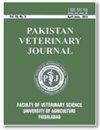土耳其传染性喉气管炎病毒分离株的分子和序列分析
IF 5.4
3区 农林科学
Q1 VETERINARY SCIENCES
引用次数: 2
摘要
感染性喉气管炎(ILT)是影响全球家禽业的一种经济上重要的呼吸道疾病。本研究的目的是通过测序和聚合酶链反应-限制性片段长度多态性(PCR-RFLP)来表征土耳其ILT病毒(ILTV)分离株。本研究使用了2003年和2018年从土耳其蛋鸡中获得的ILTV分离株。采用PCR方法对分离株的ICP4、gG、gE和TK基因区进行分析。利用扩增产物进行RFLP分析,确定菌株间的差异。对TK和ICP4区进行序列分析,采用极大似然法构建系统发育树。然后计算5株分离株和Genbank中其他菌株/分离株的核苷酸同一性值。此外,还将ICP4基因起始和结束区域的约200个氨基酸序列与Genbank中的其他菌株进行了比较。PCR-RFLP分析表明,土耳其ILTV分离株毒性较低。总体而言,土耳其菌株与其他国家菌株的TK和ICP4基因区核苷酸序列相似性均在95%以上(埃及和孟加拉国部分菌株分别为41%和45%);在氨基酸序列上,接近100%。因此,PCR-RFLP结果在许多基因区域是相似的。然而,ICP4和TK基因区域的进化分析并没有基于地理分布或致病性水平得出可靠的结果。为此,不同的方法,如贝叶斯分析或涉及来自不同基因区域的样本,可以产生更可靠的结果,就像全基因组测序一样。©2020 PVJ。版权所有本文章由计算机程序翻译,如有差异,请以英文原文为准。
Characterization of Infectious Laryngotracheitis Virus Isolates from Turkey by Molecular and Sequence Analysis
Received: Revised: Accepted: Published online: February 22, 2020 April 27, 2020 May 12, 2020 June 08, 2020 Infectious laryngotracheitis (ILT) is an economically important respiratory disease affecting the poultry industry worldwide. The aim of this study was to characterize the Turkish ILT virus (ILTV) isolates by sequencing and polymerase chain reaction-restriction fragment length polymorphism (PCR-RFLP). ILTV isolates obtained from laying hens in Turkey in 2003 and 2018 were used in this study. The isolates were analyzed for ICP4, gG, gE and TK gene regions by PCR. The amplification products were used in RFLP analysis to determine the differences among the isolates. Sequence analyses of TK and ICP4 regions were carried out and a phylogenetic tree was formed by using the Maximum Likelihood method. Nucleotide identity values were then calculated among five isolates and other strains/isolates in Genbank. In addition, about 200 amino acid sequences of the start and end regions of the ICP4 gene were compared to other strains in Genbank. PCR-RFLP analysis indicated that Turkish ILTV isolates were low-virulent. In general, the nucleotide sequence similarities of the TK and ICP4 gene regions among Turkish isolates and others was more than 95% (lower in some Egyptian and Bangladeshi strains, 41 and 45% respectively); in the amino acid sequence, it was close to 100%. As a result, PCR-RFLP results were similar in many gene regions. However, evolutionary analysis of ICP4 and TK gene regions did not yield reliable results based on geographic distribution or pathogenicity levels. For this purpose, different methods, such as Bayesian analysis or the involvement of samples from different gene regions can yield more reliable results, just like whole-genome sequences. ©2020 PVJ. All rights reserved
求助全文
通过发布文献求助,成功后即可免费获取论文全文。
去求助
来源期刊

Pakistan Veterinary Journal
兽医-兽医学
CiteScore
4.20
自引率
13.00%
发文量
0
审稿时长
4-8 weeks
期刊介绍:
The Pakistan Veterinary Journal (Pak Vet J), a quarterly publication, is being published regularly since 1981 by the Faculty of Veterinary Science, University of Agriculture, Faisalabad, Pakistan. It publishes original research manuscripts and review articles on health and diseases of animals including its various aspects like pathology, microbiology, pharmacology, parasitology and its treatment. The “Pak Vet J” (www.pvj.com.pk) is included in Science Citation Index Expended and has got 1.217 impact factor in JCR 2017. Among Veterinary Science Journals of the world (136), “Pak Vet J” has been i) ranked at 75th position and ii) placed Q2 in Quartile in Category. The journal is read, abstracted and indexed internationally.
 求助内容:
求助内容: 应助结果提醒方式:
应助结果提醒方式:


